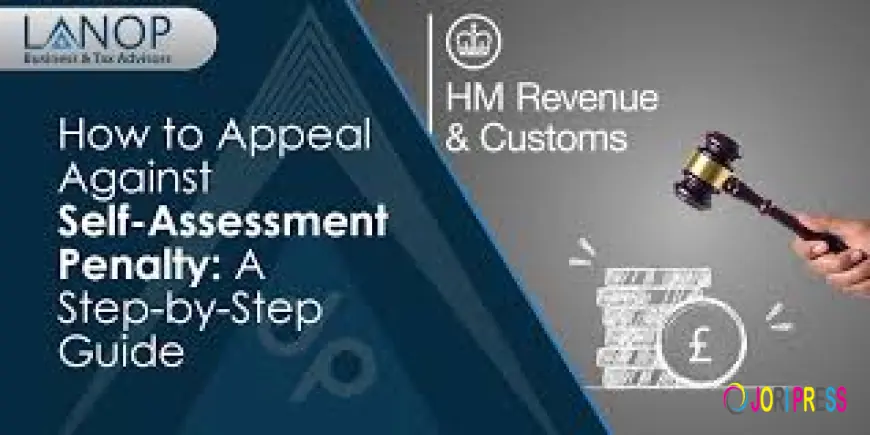How to Appeal Self-Assessment Penalty Step-by-Step
Learn a step-by-step guide on how to appeal against self-assessment penalties effectively and protect your financial interests.

How to Appeal Against Self-Assessment Penalty: A Step-by-Step Guide
Facing a self-assessment penalty can be stressful for any taxpayer. Whether the penalty arises from a late submission, incorrect calculation, or other discrepancies, understanding how to appeal is crucial. For professional guidance, services like Lanop Business and Tax Advisor can provide expert advice on navigating the process efficiently. In this article, we will provide a detailed, step-by-step guide on how to appeal against self-assessment penalty to help you address these challenges effectively.
Understanding Self-Assessment Penalties
A self-assessment penalty is a financial charge imposed by tax authorities when an individual or business fails to meet tax obligations accurately or on time. Common reasons for penalties include late filing, underpayment of tax, or inaccuracies in submitted returns. Recognizing the type of penalty is the first step in building a strong appeal.
Penalties are generally categorized into:
- Late Filing Penalties – Applied when tax returns are submitted after the deadline.
- Late Payment Penalties – Imposed when owed taxes are not paid on time.
- Inaccuracy Penalties – Resulting from errors or misreporting in your tax return.
Understanding which category your penalty falls into helps determine the grounds and method for appeal.
Step 1: Review the Penalty Notice
When you receive a penalty notice, it is essential to review it thoroughly. Check the following:
- The reason for the penalty
- The amount imposed
- The date by which you must respond or appeal
Careful examination ensures that your appeal is targeted and addresses all specific concerns raised by the tax authority. Often, minor clerical errors or miscommunications can be clarified at this stage without requiring a formal appeal.
Step 2: Determine Your Grounds for Appeal
A successful appeal must have valid grounds. Common acceptable reasons include:
- Errors by the tax authority – If the penalty is incorrectly calculated or applied.
- Reasonable excuse – Situations beyond your control that prevented timely filing or payment, such as severe illness, postal delays, or technical issues.
- Disproportionate penalty – Cases where the penalty is excessively high relative to the error or delay.
Documenting evidence to support your grounds strengthens your appeal and demonstrates your diligence.
Step 3: Gather Supporting Documentation
Supporting documentation is critical in substantiating your appeal. Relevant documents may include:
- Copies of tax returns and correspondence
- Proof of payment or filing dates
- Medical certificates or evidence of exceptional circumstances
- Emails or communication with tax authorities regarding the issue
Well-organized documentation makes it easier for the reviewing authority to understand your case and increases your chances of a favorable outcome.
Step 4: Submit Your Appeal in Writing
Most tax authorities require a written appeal. Ensure your appeal letter is:
- Clear and concise – Explain the issue, the reason for the appeal, and the resolution you are seeking.
- Professional – Maintain a respectful and formal tone throughout.
- Complete – Include all necessary supporting documentation and reference your penalty notice.
A properly drafted appeal letter demonstrates seriousness and professionalism, which can positively influence the decision-making process.
Step 5: Adhere to Deadlines
Timing is critical when appealing a self-assessment penalty. Appeals usually have strict submission deadlines, often within 30 days of receiving the penalty notice. Missing the deadline can result in your appeal being dismissed. Set reminders and ensure all materials are submitted promptly to avoid complications.
Step 6: Consider Expert Assistance
Appealing a penalty can be complex, especially if the amount is significant or if multiple issues are involved. Tax professionals can provide valuable guidance, from reviewing the notice to drafting the appeal letter. Consulting experts like Lanop Business and Tax Advisor ensures your appeal is accurate, comprehensive, and well-supported, increasing the likelihood of success.
Step 7: Follow Up After Submission
After submitting your appeal, monitor the response from the tax authority. Some authorities may request additional information or clarification. Respond promptly and maintain copies of all correspondence. Regular follow-up shows commitment and ensures your case is not overlooked.
Step 8: Escalate if Necessary
If your initial appeal is rejected, you may have the option to escalate to a higher authority or an independent tribunal. The escalation process often requires strict adherence to procedural rules and deadlines. Preparing a clear record of your initial appeal, supporting evidence, and correspondence can help strengthen your case at this stage.
Step 9: Learn from the Experience
Regardless of the outcome, appealing a self-assessment penalty offers valuable lessons. Review what caused the penalty and implement measures to prevent recurrence. This might include:
- Setting up reminders for tax deadlines
- Reviewing returns thoroughly before submission
- Consulting tax advisors proactively for complex matters
Proactive management reduces the risk of future penalties and enhances overall compliance.
Conclusion
Appealing a self-assessment penalty requires careful planning, strong evidence, and timely action. By following this step-by-step guide, taxpayers can approach the process with confidence and clarity. Whether the penalty arises from late filing, payment issues, or inaccuracies, understanding your rights and documenting your case is essential. For professional guidance and to ensure your appeal is as effective as possible, consulting a trusted advisor like Lanop Business and Tax Advisor can make a significant difference in achieving a favorable resolution.
What's Your Reaction?
 Like
0
Like
0
 Dislike
0
Dislike
0
 Love
0
Love
0
 Funny
0
Funny
0
 Angry
0
Angry
0
 Sad
0
Sad
0
 Wow
0
Wow
0

















































